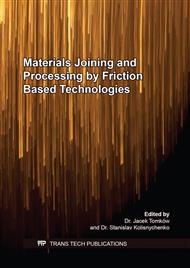p.84
p.89
p.97
p.102
p.107
p.114
p.119
p.124
p.129
On the Local Constitutive Behavior of Friction Stir Welded AISI 304 Stainless Steel Joints
Abstract:
The uniaxial tensile test is often used to determine the mechanical properties of a material like its yield strength and elastic limit. However, some of the recent advances in imaging Non Destructive Evaluation (NDE) modalities offer experimental tools which, apart from determining the conventional properties, also make it possible to visualise and map the dynamic strain evolution during monotonic loading and correlate it with the micro mechanisms of deformation. Infrared thermal imaging (IRT) and digital image correlation (DIC) are two such advanced NDE methods which are being widely used in experimental mechanics. Infrared thermal imaging maps the thermal gradient including the dynamic thermal transients that may occur during the tensile testing and is based on the detection of infrared radiation. Digital image correlation, a non-contact optical method based on grey value correlation before and after deformation, maps the magnitude of deformation on the surface of the object under load. In this investigation, the global and local properties of a friction stir welded joint of 304 Austenitic Stainless steel through the simultaneous application of thermal imaging and digital image correlation. By characterising the various stages of tensile deformation, this study enabled correlation of the thermal and strain evolutions and to provide deeper insights into the micro-mechanisms of the associated deformation phenomenon.
Info:
Periodical:
Pages:
107-113
Citation:
Online since:
March 2020
Authors:
Price:
Сopyright:
© 2020 Trans Tech Publications Ltd. All Rights Reserved
Share:
Citation:



